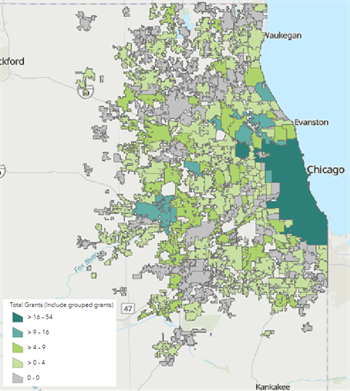
Audrey Wennink, Metropolitan Planning Council
 By Hugo Coronado
By Hugo Coronado - September 27, 2023
Biking, walking, and rolling are more than just alternative ways to get around. They are important strategies for combating climate change and improving the safety and livability of our communities. Active transportation not only contributes to a better environment but also offers numerous health benefits for the population. As communities strive to build infrastructure that makes everyone feel safe and comfortable while biking, walking, and taking transit, they create conditions for thriving and vibrant neighborhoods.
Over the past two years, the Metropolitan Planning Council (MPC), the Metropolitan Mayors Caucus, and Active Transportation Alliance have been working with communities throughout the region to support leaders in Taking Climate Action by Prioritizing Walking, Biking, and Transit. As part of this effort, we developed a new regional Bike and Pedestrian Database of municipal active-transportation related plans and grant funding received for projects.
This open-source resource provides valuable information for every municipality in the region including interactive maps documenting the extent of policy and plan development, extent of sidewalk implementation, and grants awarded for bike and pedestrian projects. This tool can help leaders learn what neighboring communities are doing and identify opportunities for collaboration on future plans.
How are we doing on planning for active transportation?
Do you know what’s the best next investment in your community to boost biking and walking? You do if you have an active transportation plan, but only 77 out of 284 municipalities in the region have one. And only 45 percent of communities include substantial information about active transportation in their comprehensive plans.
Accessibility provisions required by the Americans with Disabilities Act (ADA) also play an important role in encouraging people to walk and roll. When municipalities act to ensure that people of all ages and abilities can get around, they create an environment that benefits everyone in the community. Currently, 30 municipalities in our region have federally required ADA Transition Plans in place, and the Chicago Metropolitan Agency for Planning (CMAP) is providing technical support to assist more municipalities as they create transition plans to achieve ADA accessibility.
The database also includes plans for Transit-Oriented Development (TOD), a crucial approach that incentivizes building vibrant, walkable, bikeable places near sustainable transportation. Of the 113 municipalities with access to at least one Metra station, only 82 have TOD plans. That means more than a quarter of municipalities with access to Metra have no plans in place to boost use of the transit system though support of greater density, mixed-use development, and improved walkability around rapid transit.
Brookfield, however, is a shining example of a community that has increased density and walkability near its Metra station while preserving its suburban charm. Learn about the insights from our 2022 walking tour of this Village in our blog, Walking the Talk in Brookfield.Taking efforts to the next level involves developing a municipal climate or sustainability plan that incorporates strategies to shift people from driving to biking, walking, and transit. While 36 communities have sustainability plans, only six included specific mode shift targets. These targets serve as crucial milestones to track progress and ensure a successful transition towards sustainable transportation.
Of course, having a plan is just the beginning. We have heard from communities leading in this space that transportation committees or bicycle/pedestrian advisory committees are often critical for educating municipal leaders and maintaining momentum for implementation. In the region, 24 communities have a transportation advisory committee, 22 have a bike/ped advisory committee, and only 4 municipalities in our region have both.
Another significant challenge for local agencies striving to enhance transportation options is finding the right funding source. While Federal and State initiatives, such as the Bipartisan Infrastructure Law and the Rebuild Illinois capital plan, offer increased transportation funding, communities need to make the effort to define projects and write grant applications to fund their implementation. Since 2010, 116 out of 284 municipalities have not received any grants for dedicated bike and pedestrian infrastructure projects. Additionally, 159 municipalities have been awarded less than 10 grants, while only 10 communities have been awarded between 10 and 16 grants. For communities facing challenges, how can we assist them in being more successful? To learn more about accessing grant programs that frequently fund active transportation, check out our blog: Show Me the Money! Bringing Active Transportation Funding to Your Community.

Number of grants received for bike/ped projects
Regarding current opportunities, it is worth noting that the Federal Government has eliminated the local match requirement for the Safe Routes to School Grant this year. This funding source is administered by the Illinois Department of Transportation (IDOT), and the applications are open through October 2nd for the 2023 cycle. Check out recordings of Active Transportation Alliance’s webinar series on this grant program for projects that prioritize the safety of children. In our region, this grant has been awarded to only 84 municipalities since 2010. Now is the time for communities to take advantage of ample funding opportunities provided by the U.S. Department of Transportation via the Bipartisan Infrastructure Law.
It is also worth noting that progress is being made on other fronts to make things easier for communities to build out active transportation networks. Advocacy efforts have successfully removed barriers, such as eliminating local match for IDOT active transportation projects. And the 2023 passage of SB2278 (Simmons/Buckner) empowers communities to design safer intersections with Complete Streets elements, tailored to local context and needs.
The Bike and Pedestrian Database helps inspire and empower communities to transform their transportation landscape through improving conditions for biking and walking. Decision-makers can use this information for insights on policies, funding sources, and the status of active transportation infrastructure development in the region.
Walking and biking, sustainable and accessible modes of transportation, are making strides across the region. Through organization, advocacy and information sharing we can continue to make progress together toward better transportation for all.